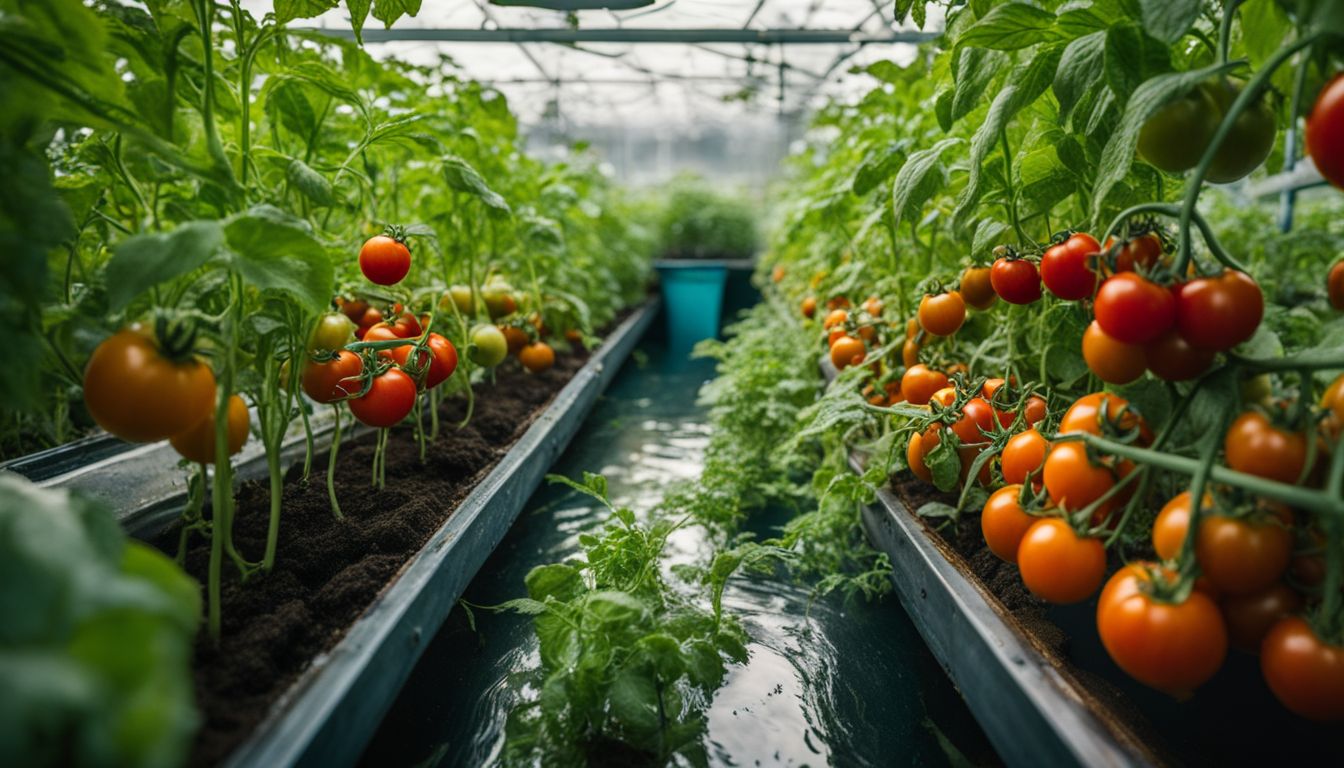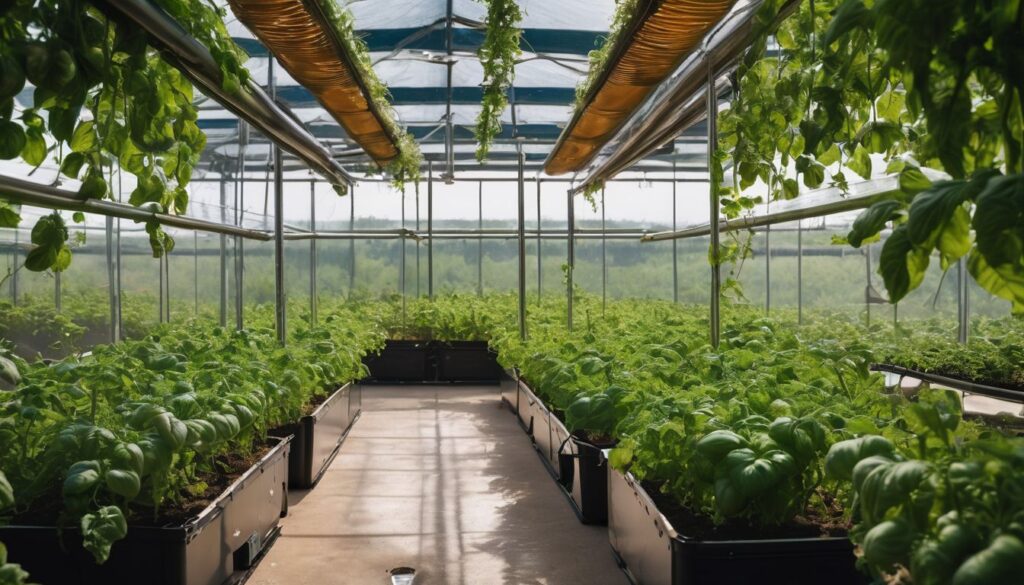Are you struggling with growing tomatoes in your garden? You’re not alone; many find this crop challenging, yet it’s the most requested to grow in Portable Farms Aquaponics Systems.
This post will guide you on the best way to apply aquaponics for tomatoes. Let’s dive into a world where farming meets innovation!
Key Takeaways
- Aquaponics is a revolutionary way to grow tomatoes that provides specific growth factors like ideal temperature, balanced water pH levels, compatible fish species for nutrient cycling, and proper nutrient requirements.
- Growing tomatoes in aquaponics offers benefits such as high yields, reduced need for pesticides and fertilizers, and sustainable farming methods.
- Best practices for growing tomatoes in aquaponics include proper spacing and sunlight exposure, monitoring water quality, controlling pests and diseases, and using pruning and trellising techniques.
- Common challenges in growing aquaponic tomatoes include preventing root rot, maintaining nutrient balance, and dealing with temperature fluctuations.
If you’re looking to diversify the plants in your aquaponics system, don’t miss our comprehensive guide on the best plants to grow in aquaponics, where you’ll find valuable insights on optimal choices for your setup.
Growth Factors for Tomato Plants in Aquaponics

Tomato plants in aquaponics require specific growth factors, including an ideal temperature range, balanced water pH levels, compatible fish species for nutrient cycling, and proper nutrient requirements.
Ideal temperature range

Tomatoes like warm air. They grow best in a temperature range of 75°F to 85°F. This is an ideal range for growing tomatoes in aquaponics systems. Too low or too high temperatures can harm the plants.
Keep them safe by controlling the heat! If it’s very cold, move your aquaponics system indoors where it’s warmer.
Water pH levels

The pH levels of the water in aquaponics systems are important for the growth of tomato plants. Tomatoes prefer slightly acidic conditions, with a pH level between 5.8 and 6.8. This range allows them to absorb nutrients effectively from the water, promoting healthy growth and fruit production.
If the pH level is too high or too low, it can lead to nutrient deficiencies or toxicities, affecting plant health and yield. Regular monitoring of water pH levels is necessary to ensure optimal conditions for tomato cultivation in aquaponics systems.
Choosing compatible fish species

To have a successful aquaponics system for growing tomatoes, it’s important to choose fish species that are compatible with tomato plants. Here are some fish species that work well in aquaponics:
- Tilapia: They are one of the most commonly used fish in aquaponics. They tolerate a wide range of water temperatures and are known for their fast growth.
- Catfish: They are another popular choice for aquaponics systems. Catfish can thrive in various water conditions and they grow quickly.
- Trout: Although they require colder water temperatures, trout can be a good option if you have a system with a chiller or if you live in a cooler climate.
- Perch: They are hardy and adaptable fish that can tolerate different water conditions. Perch also have a good growth rate.
- Koi and goldfish: These ornamental fish can be used in smaller-scale aquaponics systems. However, they produce less waste compared to other fish species, so you may need more fish to provide enough nutrients for your tomato plants.
Nutrient requirements

Tomatoes grown in aquaponics systems have specific nutrient requirements to ensure healthy growth and high yields. These plants need plenty of nitrogen during their early stages to promote strong vegetative growth.
In addition to nitrogen, tomatoes also require other essential nutrients like phosphorus, potassium, calcium, and magnesium for overall plant development. Maintaining the right nutrient balance is crucial for optimal tomato production in aquaponics.
By providing the necessary nutrients through fish waste and a balanced fish feed, aquaponic growers can meet the nutrient requirements of their tomato plants naturally without the need for artificial fertilizers or additives.
Benefits of Growing Tomatoes in Aquaponics

Growing tomatoes in aquaponics offers high yields, reduces the need for pesticides and fertilizers, and promotes sustainable and eco-friendly farming methods.
High yields

Aquaponics provides the perfect environment for growing tomatoes, resulting in high yields. With the right nutrient balance and ideal temperature range of 75°F to 85°F, aquaponic tomatoes grow quicker, bigger, and juicier compared to traditional soil-grown tomatoes.
The controlled environment of aquaponics ensures that the tomato plants receive all the necessary nutrients they need to thrive, resulting in abundant harvests throughout the year.
Aquaponic systems are also more efficient than regular permaculture planting methods, making it a great option for those looking to maximize their tomato crop production.
Reduced need for pesticides and fertilizers
Growing tomatoes in aquaponics significantly reduces the need for pesticides and fertilizers. In traditional soil-based farming, pests and diseases can easily attack plants, requiring the use of chemical pesticides to protect them.
However, in an aquaponics system, which combines fish cultivation with plant growth, natural pest control mechanisms are at work. The wastewater from the fish provides essential nutrients for the tomato plants, eliminating the need for synthetic fertilizers.
Additionally, beneficial bacteria naturally present in the system help prevent harmful pathogens and promote plant health. This organic approach not only ensures safer produce but also minimizes environmental impact by reducing chemical runoff into water sources.
Sustainable and eco-friendly

Aquaponics is a sustainable and eco-friendly way to grow tomatoes. In aquaponics systems, fish waste provides nutrients for the tomato plants, while the plants filter and clean the water for the fish.
This symbiotic relationship reduces the need for chemical fertilizers and pesticides, making it an environmentally friendly option. Aquaponic tomatoes are also grown using less water compared to traditional farming methods, further reducing their environmental impact.
By choosing aquaponics for growing tomatoes, you can contribute to a more sustainable and eco-friendly approach to agriculture.
Best Practices for Growing Tomatoes in Aquaponics

Proper spacing and sunlight exposure are key factors to consider when growing tomatoes in aquaponics.
Proper spacing and sunlight exposure

Proper spacing and sunlight exposure are important factors for growing tomatoes in aquaponics. Here are some best practices:
- Space tomato plants at least 18 to 24 inches apart to ensure good air circulation and prevent the spread of diseases.
- Place the aquaponic system in an area where tomato plants receive at least 6 to 8 hours of direct sunlight each day.
- If growing tomatoes indoors, use grow lights to provide adequate light for plant growth.
- Rotate the plants regularly to ensure all sides receive sufficient light and prevent uneven growth.
- Avoid shading tomato plants by placing taller crops or structures that may block sunlight away from them.
Monitoring water quality

To ensure healthy growth of aquaponic tomatoes, it is crucial to monitor the water quality. Here are some key factors to keep an eye on:
- pH levels: Regularly check the pH levels of the water in your aquaponics system. Tomatoes prefer a slightly acidic pH between 6.0 and 6.8.
- Ammonia and nitrate levels: Test the water for ammonia and nitrate concentrations. High levels can be harmful to tomato plants, so it’s important to maintain a balance by adjusting fish feeding and plant uptake.
- Oxygen levels: Adequate oxygenation is essential for the roots of tomato plants. Ensure there is sufficient dissolved oxygen in the water by regularly checking oxygen levels.
- Temperature: Monitor water temperature as it affects both fish and plant health. Tomatoes thrive in warmer temperatures, but extremes can be detrimental. Maintain a temperature range between 75°F to 85°F for optimal growth.
- Suspended solids: Check for any debris or organic matter that may accumulate in the system over time. Remove or filter out these solids regularly to prevent clogging or nutrient imbalances.
Controlling pests and diseases

Controlling pests and diseases is important for the successful growth of tomatoes in aquaponics. Here are some ways to do it:
- Regularly inspect plants for signs of pests or diseases.
- Remove any infected or damaged leaves, stems, or fruits immediately.
- Use organic pesticides or pest control methods to keep pests at bay.
- Encourage beneficial insects like ladybugs and lacewings to help control pests.
- Maintain good water quality and hygiene to prevent the spread of diseases.
- Rotate crops and avoid planting tomatoes in the same location year after year to reduce disease buildup.
- Keep the surrounding area clean and free from weeds, debris, and potential sources of infection.
Pruning and trellising techniques
Pruning and trellising techniques are important for growing tomatoes in aquaponics. Here are some best practices to follow:
- Remove suckers: Remove the small shoots that grow in the leaf axils of tomato plants. This helps redirect energy towards fruit production.
- Maintain one main stem: Tomato plants can become bushy, so it’s important to prune them to have a single main stem. This allows for better airflow and light penetration.
- Support with trellis or stakes: As tomato plants grow, they may become heavy with fruit. Using a trellis or stakes provides support and prevents branches from breaking.
- Tie up branches: Gently tie up branches to the trellis or stakes using soft string or plant ties. This helps keep the plant upright and prevents it from sprawling on the ground.
- Remove lower leaves: Remove lower leaves that touch the ground to reduce the risk of disease and pests.
Common Challenges and Solutions in Growing Aquaponic Tomatoes

Learn how to prevent root rot, maintain nutrient balance, and deal with temperature fluctuations when growing tomatoes in an aquaponics system.
Root rot prevention
Root rot can be a problem when growing tomatoes in aquaponics. To prevent root rot, follow these steps:
- Use well – draining growing media or net pots to provide good air circulation to the roots.
- Avoid overwatering by monitoring the moisture levels in the growing media.
- Maintain proper water pH levels (around 6.0 to 7.0) as high pH can increase the risk of root rot.
- Regularly check and clean the roots for any signs of rot or disease.
- Avoid overcrowding plants to ensure good air circulation and prevent the spread of diseases.
- If you notice any signs of root rot, remove affected plants immediately to prevent further contamination.
Maintaining proper nutrient balance
To ensure healthy growth of tomatoes in aquaponics, it is important to maintain a proper nutrient balance. Here are some key tips:
- Nitrogen levels: Tomatoes require a good amount of nitrogen during their early stages for leaf and stem growth. Regularly monitor the nitrogen levels in the system and adjust if necessary.
- Phosphorus and potassium: These nutrients are essential for flowering and fruit development. Maintain adequate levels of phosphorus and potassium to promote healthy tomato production.
- Calcium availability: Adequate calcium is crucial for preventing blossom end rot, a common issue in tomatoes. Test the water regularly to ensure sufficient calcium levels or consider adding supplements if needed.
- Micronutrients: Check for deficiencies in trace elements such as iron, manganese, and zinc. Supplementing these micronutrients when necessary will support overall plant health.
- Fish feeding: Proper feedings of fish contribute to the nutrient levels in the system. Ensure that the fish receive balanced nutrition to provide sufficient nutrients for the plants.
- Monitoring water quality: Regularly test the water pH and adjust if needed to maintain an optimal range (typically around 6-7). This helps ensure that nutrients are available to the plants without any limitations caused by incorrect pH levels.
Dealing with temperature fluctuations
Temperature fluctuations can affect the growth of tomatoes in aquaponics. Here are some ways to deal with them:
- Monitor temperatures regularly using a thermometer.
- Keep the aquaponics system in a location with stable temperatures.
- Use insulation or shading to protect plants from extreme temperature changes.
- Install fans or ventilation systems to regulate air circulation and cool down the environment.
- Consider using heaters or greenhouse structures during colder months to maintain optimal temperatures.
- Adjust fish feeding schedules to minimize heat generated from metabolism.
- Implement temperature alarms or automated systems to alert you of sudden changes.
Conclusion

Growing tomatoes in aquaponics systems offers numerous benefits, such as high yields and reduced reliance on pesticides and fertilizers. By following best practices like proper spacing, monitoring water quality, and controlling pests, you can maximize your tomato growth.
Despite challenges like root rot prevention and temperature fluctuations, aquaponic tomatoes are a worthwhile endeavor for sustainable and efficient crop production. Start growing your own juicy tomatoes using aquaponics today!
FAQs
1. What is aquaponics for tomatoes?
Aquaponics for tomatoes is a soilless farming method which uses fish waste as nutrient-rich water to grow in a controlled environment.
2. Can I use aquaponics for commercial tomatoes?
Yes, many businesses use aquaponics systems for vegetable cultivation including commercial tomato production because it is an efficient and sustainable agriculture method.
3. How can I start my own DIY Aquaponic system for growing tomatoes?
To start your own DIY aquaponic system, you need an aquarium, seeds of hydroponic tomatoes, light exposure and warm temperatures that are ideal for growing tomatoes.
4. What problems may arise while using the Aquaponic technique with tomatoes?
There might be challenges like maintaining the right temperature and balancing nutrients but these can be managed by learning more about crop production techniques specific to hydroponics and aquaponics.
5. Are there any special ways to cultivate organic or vertical farming of tomatoes with Aquaponics system?
Yes! Tomatoes grown in aquapoincs systems fit well into vertical farming methods too besides offering great scope for organic farming without using any synthetic fertilizers.

As a dedicated mother and passionate software developer, she weaves her diverse experiences into captivating stories that inspire and engage readers. Emma's love for sustainable living and environmental consciousness permeates both her personal and professional life. When she's not immersed in the world of coding and software development, Emma can be found nurturing her family and tending to her thriving organic garden. Her commitment to sustainable practices extends to every aspect of her life, from repurposing household items to embracing eco-friendly technologies.










